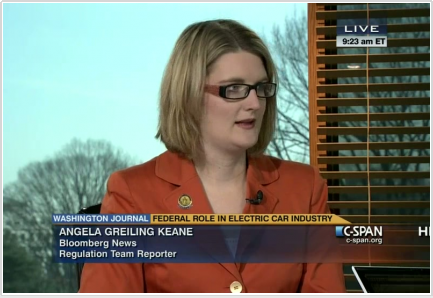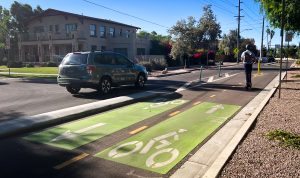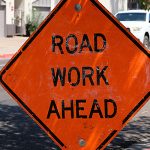Angela Greiling Keane’s reporting has taken her to the crowded intersection where autos, technology and government merge.
As a Bloomberg News reporter in Washington D.C., her beat includes transportation, auto-industry regulation and the U.S. Postal Service. Her dogged reporting earned her a Loeb finalist spot this year in the explanatory category for the story “End of Mail,” which detailed the postal service’s mounting operating losses.
Keane, who has worked on Bloomberg’s auto industry coverage for the last five years, is a graduate of the University of Missouri’s Journalism School, a vice president of the National Press Club, and a member of the Journalism and Women Symposium. In the interview below, Keane reveals how she is navigating the constantly changing industry, and how reporters outside of Washington can be effective covering autos.
1) What do you like about covering the auto industry?
Autos is a beat that touches pretty much everyone because most people drive a car. That means the stories are of high interest, especially when writing about regulations or other news that might raise costs. There’s also an element of making a difference when writing about safety because car crashes are still a leading cause of death in many age groups in the U.S.
2) How does working in Washington D.C. help you cover the auto industry?
While the epicenter of the auto industry in the U.S. is Detroit, there are so many things Washington does that affect the auto industry directly and indirectly. Having an auto reporter in Washington enables a news organization to know the regulators and policymakers whose decisions affect the bottom lines of automakers and their suppliers. Being in Washington affords the opportunity to cover hearings and meetings in person and to get to know lobbyists and regulatory decision makers at companies and their trade associations. It’s possible to do a lot of reporting by phone and e-mail, but nothing replaces the value of face-to-face interactions.
3) Technology is increasingly becoming an enhancement or distraction in automobiles, depending on who you ask. How are you covering these developments?
Distracted driving is one of the hottest stories right now on the Washington auto beat. With the recent announcement that automakers will integrate Apple’s Siri into cars, the debate escalates even more. It’s a fascinating story to cover because of the high stakes for auto companies, tech providers and cell phone providers. Even the most incremental thing a top regulator says on the topic can move markets. As a Bloomberg reporter, I’ve looked at the conflict between what automakers are saying and what they’re doing and always try to advance the ball with where key government decision makers stand on the topic. Part of a reporter’s job in covering this issue is keeping an eye on the big picture, too, and figuring out where distracted driving fits in overall car crash statistics.
4) What are the best ways for local reporters to track down auto stories in their coverage areas?
Auto statistics tend not to be localized data, but there is a wealth of federal government data in the auto realm. The National Highway Traffic Safety Administration has databases on vehicle recalls and safety defect investigations and keeps searchable statistics on defect reports and on car crash fatalities. It’s not the easiest to use, but it’s there for the taking if you’re willing to work to digest it. Automakers both foreign and domestic have manufacturing facilities around the U.S., so one way to localize auto coverage is to look at who has jobs in your coverage area and focus on that company and things that affect them.
5) What impact do lobbyists have in your coverage of the auto industry?
A lot. The automakers, even during the lean times of the GM and Chrysler bailout, are big lobbying spenders. They work with their in-house lobbyists as well as through trade associations that are more willing to speak out on controversial topics than the individual companies are. Safety and environmental groups are also part of the influence sphere, usually on the opposite side of the auto companies. Lobbyists are often the people who know issues intricately, though they often don’t want to talk for attribution.










